Posted by: Ken @ 10:16 am
Finding and identifying birds can be an end in itself, but paying special attention to what birds are doing adds an important dimension to birding. As you can tell from the following photos, we are back in our Florida home. On our first day back, in between the usual chores associated with relocation, I glanced out the back patio window.
Three male Boat-tailed Grackles were assembled breast to breast, their bills pointing to the sky:
In our neighborhood there are many nests of this conspicuous and noisy species. But the nests are hard to find, as most are hidden high in the base of palm fronds. We know the nests are there when adults start carrying food to the nestlings. Just as bull Elk collect harems of cows, the male Boat-tails stand guard over a group of females, and confront other males that enter their territory, which they advertise by calling (”singing”) and flapping from some high vantage point. One male has selected the peak of our roof to conduct such a display.
Conflicts are frequent, but they are almost always non-violent.Instead of engaging in battle, the dominant males rule by intimidation. Subordinate males often are accepted peacefully, as they may be permitted to forage within the territory. The ruling male seems to recognize subtle signs that certain other males pose a threat, and he may chase them away. As I watched the three birds in the above photo, it appeared that they were engaged in an aggressive display. After a minute or so, one of the males stopped displaying and simply walked away. The other two continued displaying. Then one of the resulting pair departed, and the “winner” stayed in place. Although I could not tell the differences between the nature of each bird’s posture and vocalization, it appeared that the remaining bird had indeed prevailed over the other two in a bloodless contest.
Wild creatures have evolved ways to conserve precious energy, and this “Cold War” is probably an example of one such adaptation. (I wish we humans could make such progress!) Interestingly, studies have shown that a significant majority of the the females in a “harem” of Boat-tailed Blackbirds are actually impregnated by males other than the dominant one– the equivalent of “spies?” (See: http://www.allaboutbirds.org/guide/Boat-tailed_Grackle/lifehistory )
A young Boat-tailed Grackle, as big as its mother and actually able to find food on its own, pesters Mama for a handout: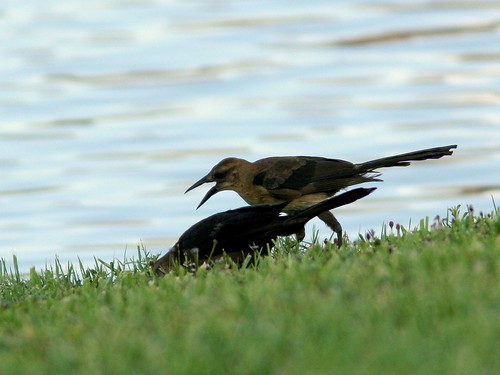
This photo shows an interaction between two Common Grackle males, part of a large flock that gathered in the wetlands adjacent to our property. This exchange seems not to be hostile:
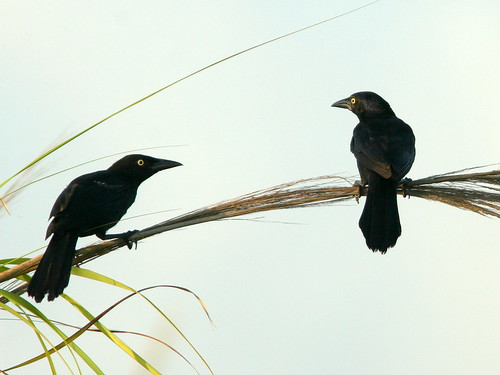
Here, a Fish Crow seems to enjoy harassing a Black Vulture atop the handball court of a nearby park: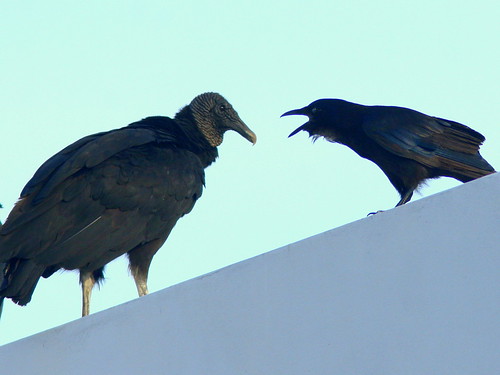
Along the edge of our lake, I saw another interesting behavior. Wood Storks are tactile feeders, with bubble-gum colored toes. Maybe their toes look like worms to attract prey into their waiting open jaws.
A pair of Wood Storks were stirring the water with their feet, which startles small fish into the trap:
Snowy Egrets hunt by sight, but they also stir their “golden slippers,” driving fish out of hiding places:
Behavior-watching provides insights into the many aspects of the life history of birds. The best places to find birds is in areas where prey is most abundant. This makes identification and better understanding of prey species a valuable asset for birders.
I was puzzled about the identity of this very large grub as it struggled in the beak of a Loggerhead Shrike:
I recognized the grub as an arthropod larva of some kind, but had never seen one this big– over two inches long. With some help from an online friend, I learned that this creature is the larval form of a Horsefly. These insects develop in the mud on the bottom of canals, and the larva can deliver a painful bite. The shrike had just carried its prey from the edge of a nearby ditch.
Mockingbirds have conspicuous white patches on their wings. When foraging in the grass, they often open their wings, presumably to scare insects into moving.
This immature Northern Mockingbird has breast streaks which will fade over the next couple of months: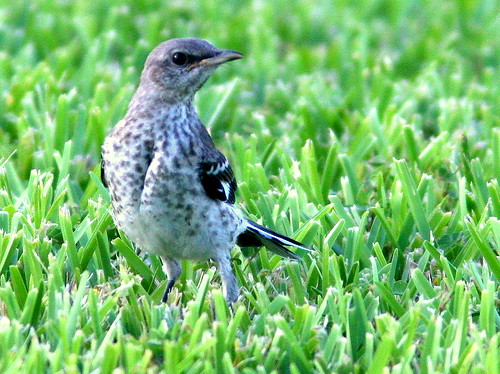
While the wing patches of the mockingbird appear to serve a useful purpose, why does this Common Nighthawk have white wing bars?:
When a friend asked me this question, I speculated:that, as with almost anything in nature, those wing spots must have a purpose, or they would not have evolved. Perhaps some ornithologist has already done research, such as covering the patches to see if they provide some advantage. Maybe they are vestiges of a trait that has become less useful as feeding habits evolved. The male has more prominent white wing bars than the female, which suggests they may provide a reproductive advantage.
Since nighthawks are crepuscular feeders and also perform courtship when the sky is quite dark, perhaps the white bars provide recognition. White-tailed deer use their white “flags” in this manner, so the members of a herd can follow each other in the dark. But, honestly I do not know, and it is a good question, for which I will try to find an answer. (Here is a link to a Blackfeet Indian legend about how the white got onto nighthawks’ wings, and also why the bird’s beak is so short)
Small things about birds can also be quite fascinating. Look at the eyes of the birds in the above photos, Boat-tailed Grackles in Florida have dark eyes, while those to the north and west have straw-colored eyes. Those Common Grackles have bright yellow eyes. See how the nighthawk’s eyes face forward to provide binocular vision,
Most of the Eastern Towhees in South Florida have yellow eyes. This red-eyed one is either an exception or an early migrant from the north:

Speaking of eyes, check out those of this immature Yellow-crowned Night-Heron that I flushed from the trailside ditch:
When birding gets dull, I tend to pay more attention to the insects. Interactions between butterflies can be interesting. For example, the White Peacock butterfly males can be seen patrolling back and forth along the paths. Almost like the grackles, the male will protect its territory against other males, and attempt to mate with any females that enter it. Since the females of this species can mate only once, they will spurn the advances of any male who did not get to her first.
The color of White Peacocks is said to change from very pale during the dry (winter) season to darker after the summer rains begin. I have taken quite a few photos of this species and cannot see a clear trend. However, the lighting conditions can produce quite different impressions of their color.
This White Peacock was photographed in full sun:
A few minutes later, I shot this one in a shady spot:













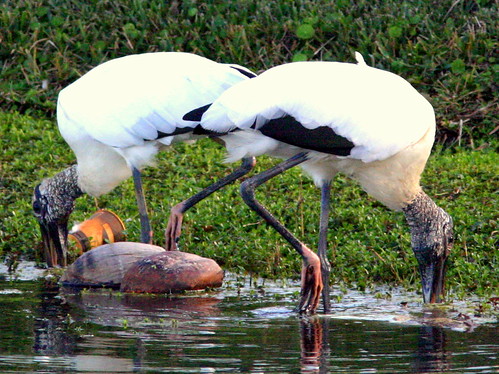
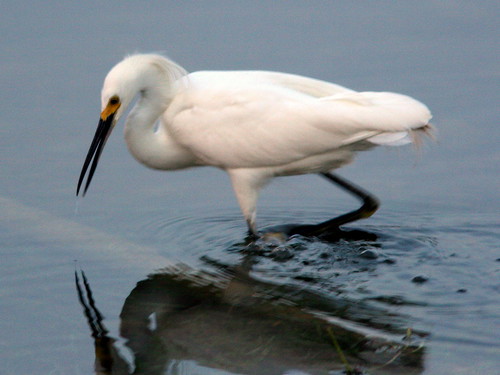
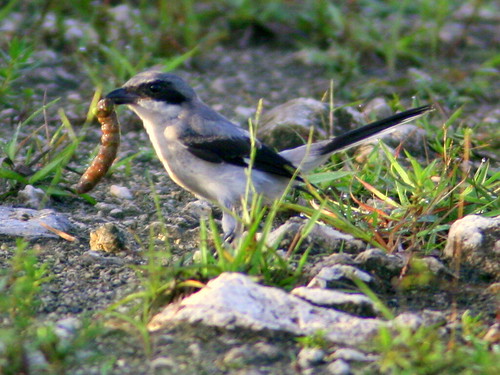
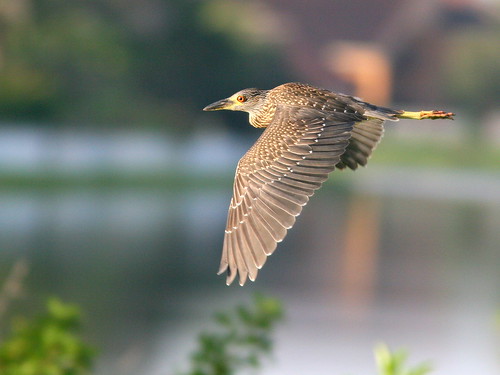
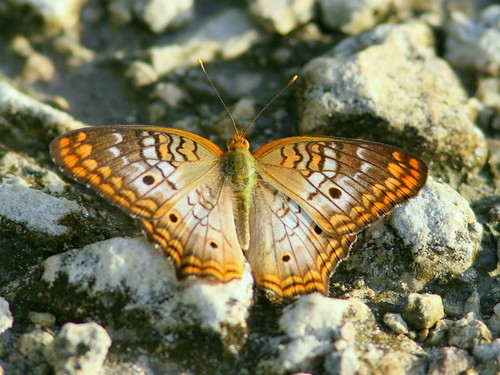

July 30th, 2010 at 8:43 am Some great pictures again Ken. The shrike certainly did us all a favour by devouring the horse fly larva. I am sure you are right about a Nighthawk’s wing marks. The European Nightjar has marks on the wings and tail which are used in dawn and dusk display and courtship to the duller females.